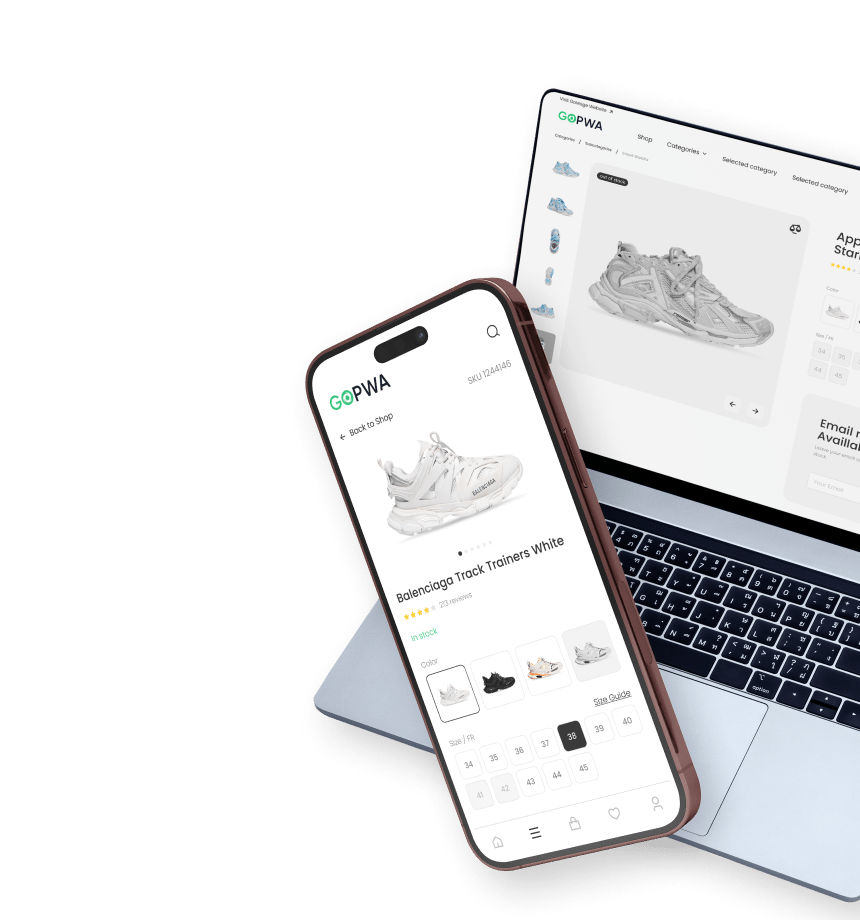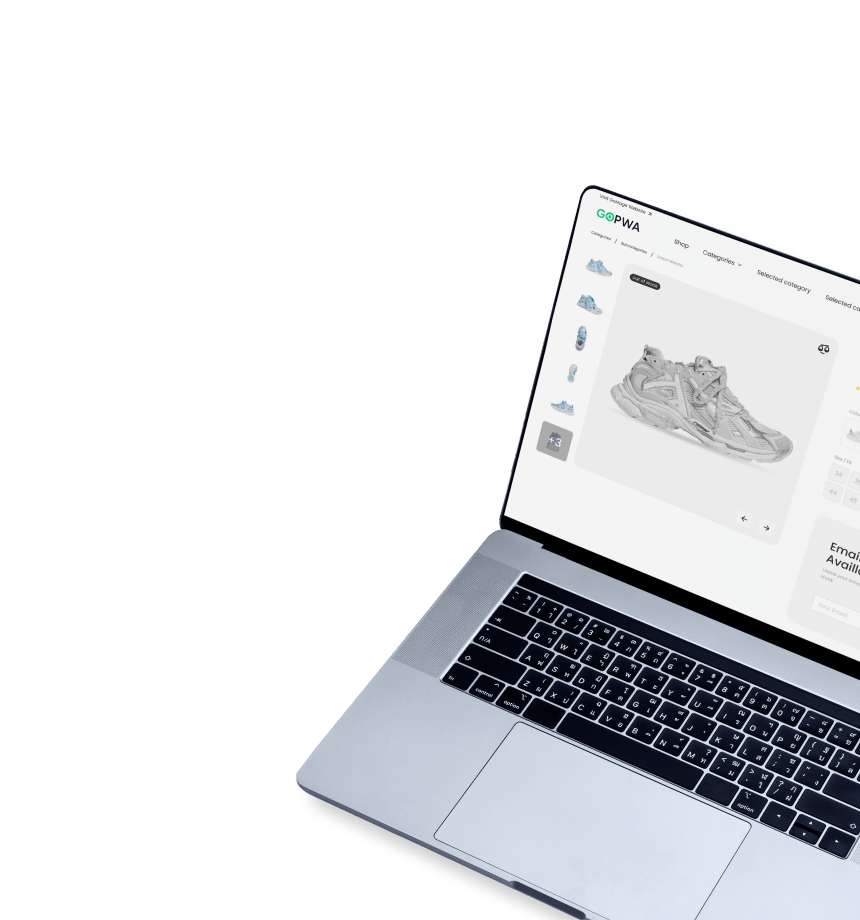The B2B eCommerce sector is undergoing a remarkable transformation. B2B user preferences change — they want the same shopping experience they got used to in the B2C online retail environment. That means, they expect an intuitive and user-friendly site with seamless navigation and checkout. A good B2B eCommerce website design is crucial here.
Let’s consider some important statistics:
- Approximately 74% of B2B purchasers conduct online research for at least 50% of their business-related purchases
- B2B buyers consider customer reviews as the most influential content that affects their buying choices
- More than 50% of B2B buyers state that numerous vendor websites lack easily accessible “about us” information
The above-mentioned facts can already hint about what you can include in your eCommerce website design to boost sales and grow your revenue. But there are many other tips and best practices you can follow to become a successful B2B online store just like Alibaba or Amazon Business. Let’s take a look at them.
#1. Ensure responsive design
B2B buyers approach website browsing with serious intent, making the website design a crucial factor that can influence their decisions. Thus, in the shift towards a fully digital approach, B2B businesses must prioritize a responsive and visually captivating web design.
The interface should be user-friendly across various devices, catering to both desktop and mobile users. Emphasizing essential design elements like simplicity, consistency, readability, and intuitive navigation is essential.
To drive higher conversion rates, the website should incorporate attractive banners featuring special offers. Moreover, personalization of the interface to align with individual client preferences can significantly enhance user experience and engagement.

#2. Provide effective search functionality
By empowering your users to find what they need quickly and effortlessly, you can strengthen their trust in your platform and foster long-term relationships. Providing an effective on-site search functionality on your B2B eCommerce website is not just a convenience; it is a strategic move to delight your customers and drive business growth. By streamlining navigation, improving product discoverability, optimizing for mobile users, gaining valuable insights, and committing to continuous improvement, you can ensure that your B2B platform becomes the go-to destination for buyers in your industry.
When implementing smart search, it is essential to prevent “zero results”, even when no products precisely match the search query. B2B websites should display complementary or recommended items to increase the likelihood of earning orders and conversions.
Furthermore, a well-prepared smart search should handle spelling mistakes or missing spaces to ensure no potential opportunities are missed for conversion. Embracing these features can significantly enhance the effectiveness of your B2B website’s search functionality.
#3. Enable real-time filtering
One essential element that significantly contributes to a seamless user journey is the implementation of effective filtering options on your website. By enabling your customers to narrow down their search results and find products that precisely match their needs, you can boost customer satisfaction, improve conversion rates, and foster brand loyalty.
#4. Focus on speed
Website load speed is equally crucial for B2B eCommerce as it is for B2C online retail. A report
by Portent shows that a website loading within 1 second converts 5 times better than a website with a loading time of 10 seconds. And that’s a huge difference! So you should try hard to provide high performance.
To achieve this, numerous online services adopt the use of a content delivery network (CDN) to efficiently deliver images, files, and other static web content. By doing so, site speed improves, and this plays a role in search engine ranking signals for search results, including Google.
The CDN stores multiple copies of commonly used files in data centers worldwide. These files are then delivered from the node closest to the shopper, reducing the distance data needs to travel and ultimately resulting in faster website loading times.
Migration Migrate seamleslly to the latest Magento version and enjoy enhanced performance, security, and functionality. Let’s make your upgrade process smooth and stress-free.

#5. Take care of security
With the convenience of online transactions comes the increasing risk of cyber threats. As a B2B eCommerce owner or manager, ensuring the security of your website is crucial to safeguard sensitive information and maintain the trust of your clients.
Here are some essential tips to focus on the security of your B2B eCommerce website, helping you create a safe online business environment:
- Invest in robust SSL certificates to ensure sensitive data, such as login credentials and payment information, is encrypted during transmission.
- Regularly update software and plugins to prevent cybercriminals from gaining unauthorized access to your platform.
- Adopt Multi-Factor Authentication (MFA) to reduce the risk of unauthorized access, even if login credentials are compromised.
- Conduct regular security audits to identify potential weaknesses and vulnerabilities on your site and proactively address any security gaps and stay ahead of potential threats.
- Implement robust website monitoring tools to detect suspicious behavior and potential cyber attacks in real-time.
- Use reputable and secure payment gateways that comply with industry standards for data protection.
#6. Offer live chat support
Live chat enables instant communication between your customer support representatives and potential buyers. Unlike traditional support channels such as email or phone, live chat eliminates the waiting time, making it more convenient for your customers to get the assistance they need. This prompt support can significantly improve customer satisfaction and encourage repeat business, as clients will appreciate the efficiency and responsiveness of your service.
Through live chat, your support team can have one-on-one interactions with customers, allowing them to understand specific needs and provide personalized solutions. This personal touch not only improves the overall shopping experience but also helps build trust and rapport with clients. By offering tailored recommendations and guidance, you can increase the likelihood of upselling or cross-selling, thus boosting your B2B sales.
Live chat allows your support team to troubleshoot problems in real-time, reducing the chances of abandoned shopping carts or lost sales due to unresolved concerns. With the ability to share links, screenshots, or product information, your representatives can efficiently guide customers through any difficulties they encounter, ensuring a smooth and seamless purchasing process.
Implementing live chat on your B2B eCommerce website offers more than just direct customer support. The integrated analytics and reporting features provide valuable insights into customer behavior, pain points, and popular product inquiries. By analyzing this data, you can identify trends, optimize your website, and tailor your offerings to better meet your customers’ needs, ultimately enhancing the overall user experience.
#7. Leverage push notifications
The power of push notifications for eCommerce websites cannot be underestimated. This dynamic feature serves as a remarkable tool for fostering strong connections between businesses and their clients. Sellers can effortlessly deliver updates, discounts, and the latest information to buyers anytime and anywhere.
Once users accept or subscribe to receive push notifications, they are treated to concise, real-time messages personalized to their preferences, delivered right through their browsers. These inherent qualities and advantages make push notifications an incredibly effective marketing tool for eCommerce sites.
Development Get a robust PWA
Supercharge your eCommerce efforts with superb UX and ‘superfast’ speed. Build an eCommerce PWA from scratch or save time and money using GoPWA Storefront.

#8. Enable offline mode
B2B businesses must stay ahead of the curve to meet the evolving needs of their customers. Offering an offline mode is a game-changer that can enhance the overall B2B customer experience.
To access products offline, it is often necessary to pre-cache certain categories, ensuring full access when not connected to the internet. In B2C industries, especially those with rapidly changing trends like fashion, one-time buyers may search for various items such as trousers, shirts, glasses, etc., requiring internet connectivity during the initial review and category selection process.
However, in the context of B2B, the situation is slightly different. B2B buyers typically order the same products or items from similar categories on a regular basis. As a result, the offline experience aligns much more closely with their expectations, making it a more convenient and seamless option.
By embracing Progressive Web Apps (PWA) as a solution, you can offer your clients the ability to work even when disconnected from the internet, enhancing their productivity and satisfaction.
#9. Provide flexible payment options
transactions often involve multiple parties spanning various regions and countries. As a result, accommodating diverse payment methods is a critical factor for business growth. Embracing a wide range of payment options not only allows B2B businesses to establish themselves as professional and global entities but also significantly enhances the potential for repeat customers.
These various payment methods encompass traditional, electronic, and smart payment options. B2B businesses must offer a diverse array of choices, including debit cards, credit cards, prepaid cards, charge cards, virtual cards, and electronic money transfers, among others.
By employing these versatile payment methods, businesses can cater to the needs of customers in the digital age, earning them greater recognition and professionalism in the eyes of their clientele. Additionally, the adoption of multiple payment solutions facilitates seamless statistics and accounting control, ensuring all transactions are transparent, accurately recorded, and easily managed.
#10. Inform about your B2B offerings
If your previous focus was on B2C or wholesale services, it’s crucial to let people know about your shift towards B2B. To support your B2B sales representatives effectively, it’s essential to communicate with potential customers in a language they are familiar with.
There are several ways to achieve this. Implementing quote buttons, credit application links, and creating a distributor/wholesale signup page are effective methods to signal your B2B capabilities to interested parties. By adopting these strategies, you can bridge the gap and establish a clear connection with your target audience in the B2B market.
Conclusions
It is estimated that B2B eCommerce sales will amount to $1.8 trillion in 2023. With this in mind, as a B2B business you shouldn’t ignore the opportunities of B2B eCommerce if you want to stay ahead in the competitive digital marketplace. And it all starts with a well-designed site.
A well-crafted B2B eCommerce website design serves as the foundation for success, empowering businesses to engage clients, build lasting relationships, and achieve unparalleled growth in the dynamic world of online commerce.






